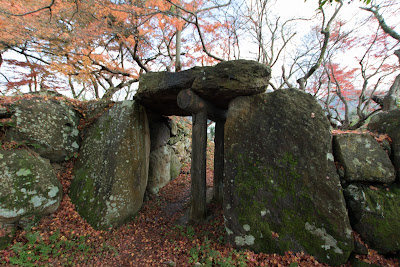Komaru Castle
-Record of suppression-
Overview
Name: Komaru Castle (Komaru-jo)
Alias:
Place: Gobuichicho Echizen city, Fukui
Type: Hill Castle
Built: 1575
Remaining remnants: Stone walls and dry moats
Title:
Brief History
Komaru castle (小丸城) is located on a small hill at the east part of current Echizen city. Echizen city is the south border of Echizen plain, and applicable to a gate from Tsuruga area into Fukui area.
This area is said as the birthplace of Emperor Keitai (?-?), who moved to Kinki region and succeeded Imperial Household in early 6th century, and is a direct ancestor of current Emperor. The hill itself is small but protruding to marsh (current rice field), it is a suitable place to build a castle. Komaru castle was built by Narimasa Sasa (1536-1588), a general of Nobunaga Oda (1534-1582) in 1575, as his residence after the conquest of Ikko Ikki at that year.
Ikko Ikki army in Echizen province
In 1471, priest Rennyo (1415-1499), the leader of Ikkoshu (one denomination of Japanese Buddhism) held his residence at Yoshizaki Gobo (at the north border of Echizen province) and started to propagate to people in Hokuriku region. As Ikkoshu was enthusiastic and strongly seek for salvation, thus Ikkoshu became a large social movement of this era.
Due to its character Ikkoshu believers formed a military group named Ikko Ikki (Ikkoshu uprising) against oppression from other denomination or rulers, and fiercely conflicted with opponents. In 1478 Renyo moved to Kinki region, but Hokuriku region was still a strong area of Ikkoshu.
In Echizen province Asakura clan, the governor of the province, succeeded to control Ikko Ikki by military power and conciliate. But Asakura clan by extinguished by central ruler Nobunaga Oda (1534-1582) in 1573, and Nobunaga used former retainers of Asakura clan to manage the province but they started internal conflicts.
Short term capture of province
Utilizing internal conflicts between new governors appointed by Nobunaga, Ikko Ikki group captured Echizen province in 1574, supported by Ishiyama Honganji temple, head temple of Ikkoshu at Osaka and colleagues of denomination in Kaga province (Ishikawa prefecture), next to Echizen province and already kept by Ikko Ikki.
As Nobunaga faced enemies in different fronts, he once just watched this situation. But due to conflict between local people and high class priests sent from head temple or Kaga province, there arose internal battle inside the group and Ikko Ikki army significantly lost their power.
On the other hand, Nobunaga extincted Ikko Ikki army in Nagashima area (Mie prefecture) just next to his native place Owari province (western part of Aichi prefecture), and broke his strong rival Takeda clan at the battle of Nagashino in 1575. Now Nobunaga could centralize his army to Echizen province again.
Suppression of Ikko Ikki by Nobunaga
Same year, Nobunaga started to invasion to Echizen province by large army from all direction of the country. Facing large army of Nobunaga, weakened and inexperienced Ikko Ikki army easily collapsed, and Nobunaga could capture whole province in short time. Nobunaga thoroughly suppressed remaining Ikkoshu believers, and placed Katsuie Shibata (1522-1583), his veteran general, as a governor of this province.
Three young generals of Nobunaga including Narimasa Sassa (?1536-1582), Toshiie Maeda (1539-1599) and MItsuharu Fuwa (?-?) were attached to Katsuie to help him, and these three lords got the territory at southern half of Fukui plain. Narimasa held current Echizen city area, and built his own castle at Gobuichi area.
Komaru castle was not a large castle, but its central area was covered by stone walls and thought to have a main tower. Secondary area and third area located next to central area, and whole part of castle were surrounded by moats and marsh. But in 1581 along with the expansion of territory Narimasa became a commander of Toyama castle (Toyama prefecture), and Komaru castle was abolished only after five years from construction.
Record of suppression
In 1932, during the investigation of this castle, a roofing block used for a turret was discovered. At the backside of this block, there remains a sentence stating Toshiie Maeda killed many Ikkoshu believers when Oda army occupied Echizen province.
The purpose of this block is also describe to record the fact for future leader, and it is thought to be written by surviving craftsman who believed Ikkoshu. In that sense, the intention of this person are achieved as intended.
Now the site of castle became ruin but a built in stone gate and stone walls of connecting path remain. Terrain of castle including clay walls and trace of moats also exist, and we can still grasp rough shape of the castle.
Access
15 minutes drive from Hokuriku Jidoshado Expressway Takefu interchange.
Related Castles
Toyama Castle -Pride and honor resisted to ruler-




































































































No comments:
Post a Comment